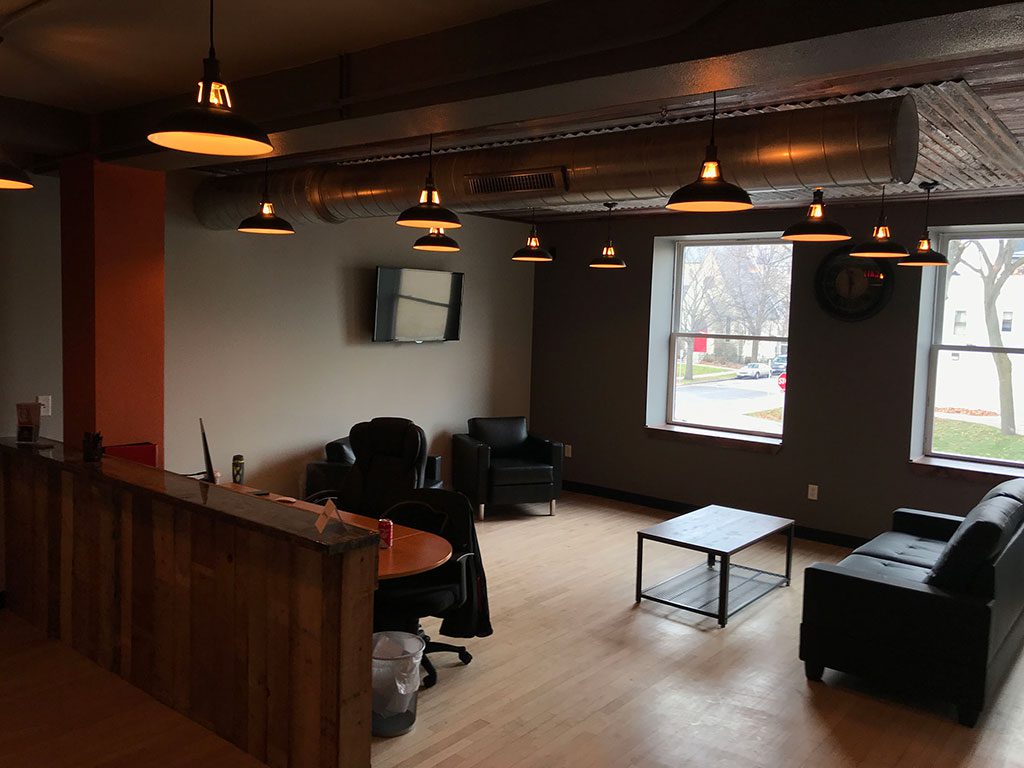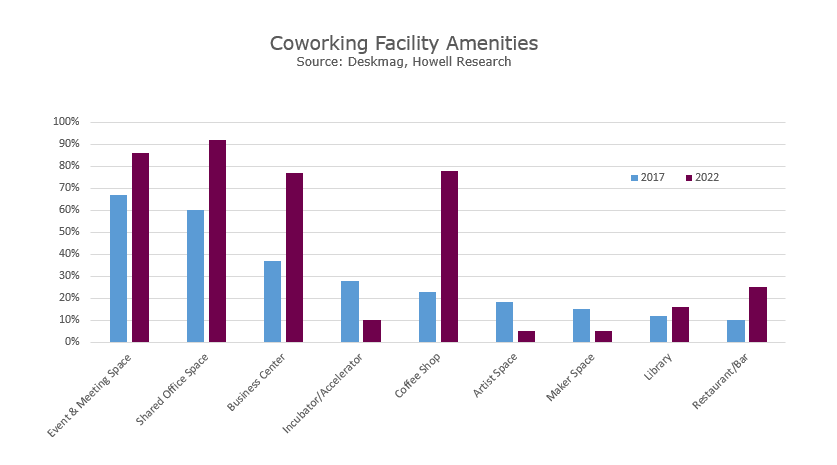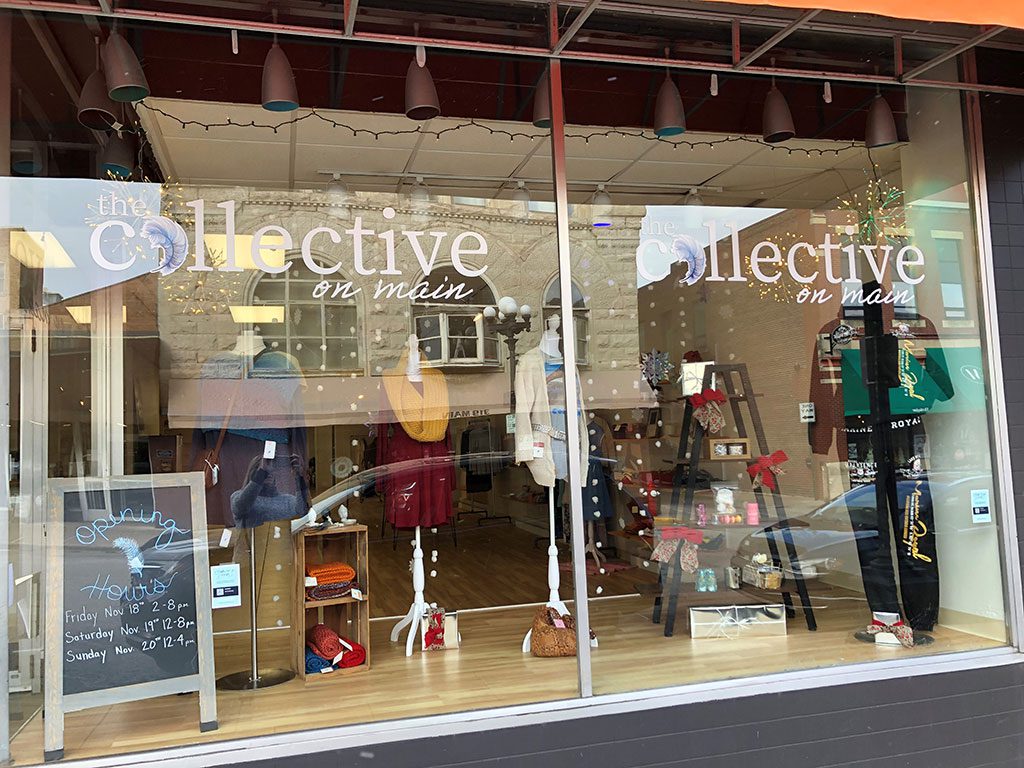
Green Bay’s Urban Hub provides a collaborative workspace for area entrepreneurs and remote workers. Pictured is Urban Hub Community Manager Lamarr Banks. Photo credit: Audrey Thomas Photography.
March 2023
Downtown is a different place today, as our workplaces have changed.
The pandemic forced a lasting transition to hybrid and work-from-home models, dramatically shifting downtowns’ daytime customer base. But communities are discovering that coworking spaces offer an important way for businesses to find and engage daytime workers downtown and keep Main Streets vibrant.
The coworking market has significantly evolved since appearing around 2010. No longer just techy hubs, these spaces provide a much-needed service for today’s office workers, with successful coworking models in nearly every geography and industry.
Let’s explore today’s coworking trends and how Wisconsin communities can attract and embrace these spaces as drivers of downtown success.
Today’s coworking spaces

Green Bay’s Urban Hub, Community Manager, Lamarr Banks Photo credit: Audrey Thomas Photography
In 2022, the number of U.S. coworking spaces grew to more than 20,000, with an estimated 1 million individuals using them annually. The market for coworking grew as the industry evolved, with all ages and genders finding a home in coworking. Small suburban and rural coworking communities are particularly diverse, attracting a wide cross section of self-employed, work-from-home and those just seeking modern office amenities to be more productive.
Coworking spaces have created lively and collaborative outlets for our small business community,” says Brian Johnson, executive director of On Broadway Inc. “We have seen successful programming, low-cost startups, and relationship management that all contribute to a strong, thriving entrepreneurial ecosystem that helps position our district as an attractive destination for the creative class.”
Freelance and startup workers are still the largest single categories of users, but nearly every sector is represented, with corporate headquarters for companies both large and small, satellite offices, remote workers, and traveling professionals representing key growth opportunities. This diversified clientele means space use has also changed, with only 22% of today’s users working exclusively in coworking spaces.
Depending on the client, coworking spaces provide a change of scenery, add professional networking opportunities, allow for client meetings in professional and neutral settings, and provide educational and social opportunities.
Recent surveys by DeskMag and Small Business Labs found that coworking users report the following reasons for joining a coworking space: 84% said they felt more motivated in a coworking space, 83% felt less isolated, 82% were able to expand their professional network, and 76% joined a space to be with like-minded people.
The surveys also found that:
- 67% gained professional contacts or skills.
- 60% find these spaces to be a good value.
- 58% said proximity to home was a key factor.
- 45% are drawn by events and training offerings.
Instead of wide-open spaces with plug-and-play cubicles and ping-pong tables, today’s coworking spaces include a wide array of arrangements. They have amenities such as meeting rooms, shared workspace, private offices, private phone booths, coffee shops, lounge areas, and more. Industry-specific spaces have also emerged, such as health and wellness spaces with reservable treatment rooms.
Since many users are visiting the spaces during one or two days out of the home office or in the host community, amenities have become geared toward maximizing productivity and convenience, allowing users to complete their errands in the same trip. The chart below shows the change in amenities over the past five years. Notably, the list of amenities identified is nearly twice as long in 2022 as it was in 2017.

Downtown Kenosha Inc. uses this coworking space because it provides the conveniences and amenities of a large office with the high lease cost.
I thoroughly enjoyed having an office in the coworking space in downtown Kenosha. Since we are a very small organization with only two staff members, the coworking space gave me a sense of expanded community and outreach. I was able to connect with other businesses that cohabited the building, on a professional and personal level. This provided me the opportunity to collaborate with them and exchange services, such as fundraising and events. Additionally, it was a great financial decision, as it gave us the conveniences and amenities of a large office without the high lease cost.” – Gretchen Covelli, Downtown Kenosha Inc.
How coworking works
 With a variety of geographies and clientele, coworking spaces range from 1,000 square feet in a downtown storefront to tens of thousands of square feet in urban office buildings.
With a variety of geographies and clientele, coworking spaces range from 1,000 square feet in a downtown storefront to tens of thousands of square feet in urban office buildings.
The average facility is just shy of 10,000 square feet. Similarly, there are myriad ways these facilities are financed and operated, including:
- In large markets, spaces generally rely on monthly memberships and facility rental fees to cover costs, with a designated break-even membership level.
- Regional hubs and college towns are often fortunate to have established incubators or entrepreneurial support organizations. They create coworking spaces to provide additional services to, and attract users for, their incubator or accelerator programs. Such facilities may receive grants or institutional funding and rely on a target number of businesses rather than membership as a measure of success.
- In small communities, coworking spaces often occupy surplus space adjacent to an existing business. The host business may be civic-oriented, such as a chamber of commerce, Main Street office, or also may be a business service provider benefiting from the ability to collocate with clients or vendors.
- Lastly, there are many businesses—especially businesses built around a community of like-minded users—that have established a coworking space within their business. This space might be a perk for existing members or a way to entice remote workers to frequent the business during slow periods. Examples of frequent categories of host businesses include coffee shops and fitness facilities.
A 2022 survey by Deskmag found that 40% of coworking spaces are profitable and 72% become profitable within two years of beginning to operate. The average monthly membership rate nationally is $243 but varies greatly depending on whether the user prefers a dedicated office and whether amenities are included in the membership or purchased separately.

Local Tomi Stoyanova got her own company, ToyVentive, off the ground in 2018 at CoLab and hasn’t looked back since.
Coworking success stories
“Initially, I remember thinking, ‘I’m not very good at this.’ I just didn’t know how to do online marketing or things like that, and it took me years to know what I know now. I took full advantage of the trainings at CoLab, like the entrepreneurial training done by UW-Eau Claire, and I found my bank, Northwestern Bank, through CoLab.”
Wisconsin has a variety of coworking and collaborative workspaces that have gained traction in their communities. Here is a look at some of them:
- The Nest, Green Bay: Focuses on women and mothers, the Nest features coffee shop-style coworking, events, and workshops.
- The Urban Hub, Green Bay: This is a modern space managed by the Greater Green Bay Chamber and designed to attract entrepreneurs, remote workers, and corporate users.
- Venture Project, Oshkosh: This 7,500-square-foot art deco-inspired downtown coworking space and business incubator has shared office space, marketing services, and business resources.
- Rise and Grind, Oshkosh: This franchise model with multiple global locations features high-tech housing, a café, events, and programming.
- Greenspace Coworking, Fond du Lac: Greenspace is a traditional coworking space offering flexible plans, meeting rooms, business training, and events.
- Irontek, Beloit: This incubator-based coworking space has an industrial feel, offering coffee, beer, wifi, 24-hour access, and meeting space.
- Focus Coworking, Jefferson offers flexible office space, conference rooms, and fast wifi, and hosts community and training events.
- O Coworking, Kenosha: This operation offers flexible spaces and membership options, with kitchenette and conference rooms.
- Venture X, Racine offers professional executive office space, 24/7 access, and a café and lounge area.
- Appleton Coworking, Appleton: This member-driven, nonprofit community targets creative and tech industry professionals, emphasizing openness, accessibility, and sustainability.
- Jake’s Café, Sheboygan: Jake’s offers hourly, monthly, and yearly membership models for office, meeting, and event space. Located in a converted historic home, it features high-tech meeting amenities, a receptionist, and production workspaces.
- The Office, Sheboygan: This 24/7 office coworking space has daily, monthly, or punch-card options.
- Palace Meets Coworking, Evansville: This operation has traditional office space with private offices and drop-in or event rental options.
- CoLab, Eau Claire partners with WiSys and the university, offering flexible workspaces, conference rooms, and training, plus a virtual office membership that provides a professional business address and mail service along with conference room use.
For additional data about coworking facilities and a more comprehensive list of Wisconsin and small community-based coworking facilities, see our 2023 Coworking Facility Summary. (Sources: AskWonder, DeskMag, Clutch)

The Collective incubator, located at 320 Main St., La Crosse, hosts six businesses and hopes to expand.
Businesses embrace coworking spaces
“This has been my biggest dream for as long as I can remember,” says Chris Bouquet, owner of Trendcessory, a Black-owned business featuring clothing and accessories that Bouquet and his girlfriend curate and design.
Some Wisconsin businesses that recognize the benefits of collaborative spaces have also become home to coworking spaces. Here’s a look at some examples across the state:
- Boulders Climbing Gym, Madison: The gym features a lounge, coworking space, and free wifi at its downtown location.
- CoworkCafe: This hybrid café and coworking space has multiple locations across the state.
- Indoorance Athletic Club, Madison: This high-tech gym with a cryochamber and an infinity pool also offers coworking packages including wifi, coffee/espresso, and massage chairs.
- The Buzz Café, Kenosha: This café promotes remote working, with online check-in required for wifi password.
- Brix Coworking, Madison: Focused on the music industry, Brix offers office space plus access to recording equipment, podcast studios and mentoring programs.
Far-flung operations
These examples of some coworking spaces in other states (and one Canadian province) highlight the creative options that exist in this space:
- The Ember Coffee Ice Cream Coworking (Monticello, Minnesota): This coffee roastery offers professional workspaces in its upstairs space, as well as free coffee, flexible access, and mail service.
- OfficeLinx (Port Hope, Ontario): This small-town coworking space has a café and an on-site child care facility.
- Space (West Chester, Pennsylvania): Billing itself as a business club, it offers free hot breakfast and event space.
- Speakeasy 10562 (Ossining, New York): This coworking space focuses on creative workers; it also offers “Zoom rooms” for remote workers seeking a professional video background and virtual membership for mail services, networking, and conference space.

Pictured: Gallery Q artist/owners Joan North and Pat Gaska. Photo Credit Joan North
Spaces cater to specific segments
As a cooperative, we are owned and democratically controlled by those who produce the art and exist to meet the needs of the members by marketing fine art. Our members are all working artists who pay dues to cover expenses, work gallery hours, serve on committees, and actively participate in the running of the business. You will most likely meet a different artist each time you return to the gallery.” ~Joan North, Gallery Q artist/owner
In some cases, specialized collaborative business models target specific industries such as art or retail.
GalleryQ Artist Cooperative, Stevens Point: The cooperative is owned and operated by a cooperative ownership board made up of fine artists. Artist-owners pay dues to cover expenses as well as working gallery hours and actively participate in running the business. New artists join by application and an associated jury process, which ensures a wide variety of artistic styles and mediums.
The Collective on Main, La Crosse: This retail incubator opened in December 2022 and provides entrepreneurs opportunities to grow into storefront retail. The store is operated by collaborative vendors, with each working at least 15 hours per week and one weekend per month. This allows the store to be open from noon to 8 p.m. daily. Tenants pay a graduated rent structure over time as well as a monthly fee for items such as bags and cleaning supplies. The space can accommodate 8 to 10 vendors, with a goal of graduating tenants after a year to accommodate new would-be retailers.
Bronzeville Collective, Milwaukee: This retail shop on Milwaukee’s King Drive grew out of a pop-up shop program offered by the City of Milwaukee. Two of the initial pop-up tenants pitched the concept at a RISE MKE competition and were awarded $3,000 to make the business a reality. Today, the collective features more than two dozen local brands, with a focus on creatives of color—and all the available products crafted and/or designed by local creators. Businesses pay a low monthly fee plus commission in exchange for space in the shop and a presence at outside pop-up events or festival booths.
These examples demonstrate the diversity, features, and benefits of coworking spaces in downtown areas as workplaces have transformed and become more flexible.
These spaces—in all their forms—foster innovation, build community connections, support creativity and entrepreneurship, and attract downtown workers. Their benefits spill over into the community as they promote daytime customer spending and vibrancy, help workers, foster employee engagement, and support nearby businesses.
